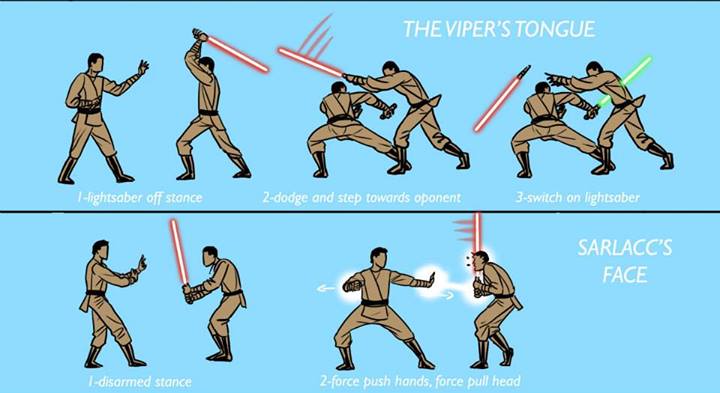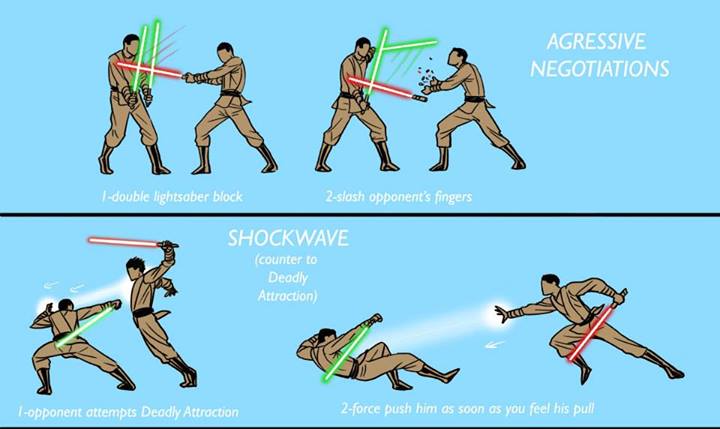I have thought about Jedi duels a long time. I may have obsessed a wee bit much in this answer.
In the Star Wars universe, only Jedi and Sith use lightsabers as weapons because they're just too dangerous to use unless you have some level of prescience from your attunement with the force. Only a handful of individuals are known to wield a lightsaber without force attunement, and those who did so in combat did not last long (see General Greivous). Accordingly, I will presume your fighters have some Jedi like skillsets to avoid killing themselves by mistake.
Jedi and Sith alike are known for their long game. The Jedi order sought to maintain balance for thousands of years. Darth Sideous had the gumption to fight two sides of a war for years before assuming ownership of the winning side. A Jedi or Sith will leave nothing to chance. Accordingly, we can rely on them to never act in a way which can perceptibly increase their chance of losing their long term goal. You won't see a Jedi or Sith make an attack that has a 95% chance of killing the other person and a 5% chance of getting stabbed themselves (unless killing that person is their long term goal or their long term goal can be achieved after death). Allowing random external influences to negatively affect their long term goals just isn't in their nature. Jedi and Sith trust the force, not dice. Instead, they will put themselves in positions which make their odds look more and more likely until they are convinced they have a 100% chance of achieving their long term goal -- and if that involves killing the other person, they will.
The force does not give perfect information, or if it does, it requires a perfect person to listen to it fully. So let's set some ground rules for what a force-aware person can sense. We note that Jedi can deflect blaster bolts, which suggests that they can be aware of the physical state of their opponent. Whether it's the position of an ankle joint, or the direction of a blaster, they're likely aware of all of it. However, intent is trickier. It is noted that Jedi mind tricks only work on the weak minded. Canon Star Wars doesn't specify what this means, so I'll define it in a way which is convenient for talking about combat as a game. I will define "intent" to be a plan to control a state, such as the physical state of the opponent. For instance, if you have the intent to punch someone, that intent will guide the muscle contractions required to develop a high velocity in your fist (the physical state) towards them. This concept of intent is recursive: we can have an meta-intent shaping intent. For instance, you could have an meta-intent to win the fight, which shapes the intent to punch someone, which shapes the muscle movements needed to strike. A strong minded individual will be defined to be one with many layers of intent, like an onion, or one with very sharp and focused intent. A weak minded individual will be defined to be one with few weakly focused intents. Jedi and Sith are limited in the number of layers of awareness they can pierce, and by the sharpness of those layers. This is perhaps contrived, but it does line up well with the canon. If Obi Wan is sufficiently attuned to the force to be aware of all the layers of intent in the mind of a Storm Trooper, he can identify the exact set of motions which will exploit a weakness in that storm trooper's mind. If the storm trooper had a stronger mind, he'd have been unable to do so because a higher level of intent (which he is insufficiently aware of to influence) will catch his Jedi mind trick, and "correct" it. Alternatively, consider Watto, who clearly doesn't have many layers. He may not have many layers, but the layers he has describe very clear intent (to make money, mostly), so its hard to find a way to influence him without being detected. (I'd theorize that Qui Gon could have completely dominated Watto's mind, wiping all intent, but that'd be against the ways of the Light Side).
Wow, it takes a lot of setup to explain a light saber duel, but we have all of the ground rules in place. Both parties are defined to be "strong minds," so they have many layers of intent. The game is technically decided by the physical state of the world (first to put a lightsaber through the other without dying, themselves, wins), but that game is played with "perfect knowledge." Both parties know the exact limits of motion for every joint. Both parties have an onion like set of layers of intents. The inner layers are inaccessible to the other (strong minds), but the outer layers may be suggested to by acting in a way which encourages those layers into a suggestible position. The Jedi will attempt to move in ways which suggest the Sith no longer oppose the Jedi's true goals, and vice versa (which tends to involve a lightsaber burn, but doesn't have to -- see the end of Return of the Jedi!). Each party may act in a way which makes a very obvious suggestion (which is powerful, but easily detected and corrected for) or a very subtle suggestion (which is less powerful, but much harder to uproot). These suggestions can be done at outer layers (where it's easy, so obvious suggestions are fair game) or inner layers (where it's much harder to influence, so subtle suggestions will dominate).
Game theory suggests how to play this game. If you can find an outer layer for which an obvious suggestion is sufficient to permit you to not-loose, take it. This happens all the time when facing Storm Troopers - all you have to do is move in a way which encourages them to miss all the time. However, a Jedi or Sith who has such weakness is a very weak force-aware indeed. The force should have warned you about such weaknesses long ago. Accordingly, any weakness you see in early combat is likely a trap designed to catch the less enlightened. If you try for the easy victory, influencing the "trapped" chink in their armor, the motion you used to influence it may spell your undoing, as they influence you more subtly, preventing you from causing them to lose. Jedi and Sith battles focus at the inner most layers that each can observe in the other. Accordingly they are incredibly subtle. If you can be more subtle than the other party, you can influence them in a way which eventually prevents you from losing (which may involve a joint mobility limit which permits you to kill them).
We can use this information to see more into what the strikes must look like. When you see a strike that isn't a deathblow, its goal is clearly to get more information. If you can learn more about the inner layers of intent of your opponent, you can subtly influence them at more inner layers. This means, with each strike, the Jedi remains sensitive to what the opponent is doing. When the opponent successfully blocks the attack, the way they block the attack can reveal information about inner layers which the Jedi could not otherwise pierce. For example, if the block reveals a Sith inner desire to strike at the lower right quadrant of the Jedi, the Jedi can offer "opportunities" in that quadrant which don't cause the Jedi to risk losing, but permit the Jedi to learn more about the Sith. This would suggest that the violent uncontrolled swings of Anakin vs. Count Dooku were not the swings of a Jedi, but a fool masked by anger because they put his senses in a very poor position to analyze the way Dooku's blocks "felt."
Likewise, this also points out that the taunts in combat are actually valid combat techniques. While taunting may be seen as a cheap way to make lesser opponents make a mistake, at the skill level of the Jedi and Sith, words may be as effective at subtle influences as a lightsaber is.
The long strung out fights with many blocks and parries may be realistic! Modern fighting theory suggests that most fights are over within the first few blows. However, modern fighting theory is not studying Jedi, with their extraordinary levels of perception. In a Jedi fight, you aren't always fighting to kill the other guy; you're fighting to get information about them so that you can influence them in a way that ensures you don't lose. This can lead to much longer fights than happen in more realistic circumstances, with less super-aware individuals.
What's the ultimate Jedi/Sith lightsaber battle? It's actually really boring to watch, because it is too subtle for us. I borrow from the stories of a Chinese internal martial art called Tai Chi.
Two great masters of the force met to determine whose mastery was greatest. They stood and faced each other, staring the other in the eye. They stood there for the longest time, never drawing their lightsaber, never twitching a muscle. Finally, both smiled, bowed, and walked off.
Why do I suggest this is the ultimate lightsaber battle? Consider, neither one would like to leave their ultimate victory up to chance. Not-losing is more important than winning. In the ultimate lightsaber fight, both parties influence each other so subtly that even the drawing of the lightsaber is superfluous. Eventually they identify a way to proceed in which both parties do not lose, and they go on their way.










